ECU CADILLAC ESCALADE EXT 2006 2.G Owners Manual
[x] Cancel search | Manufacturer: CADILLAC, Model Year: 2006, Model line: ESCALADE EXT, Model: CADILLAC ESCALADE EXT 2006 2.GPages: 484, PDF Size: 2.98 MB
Page 7 of 484
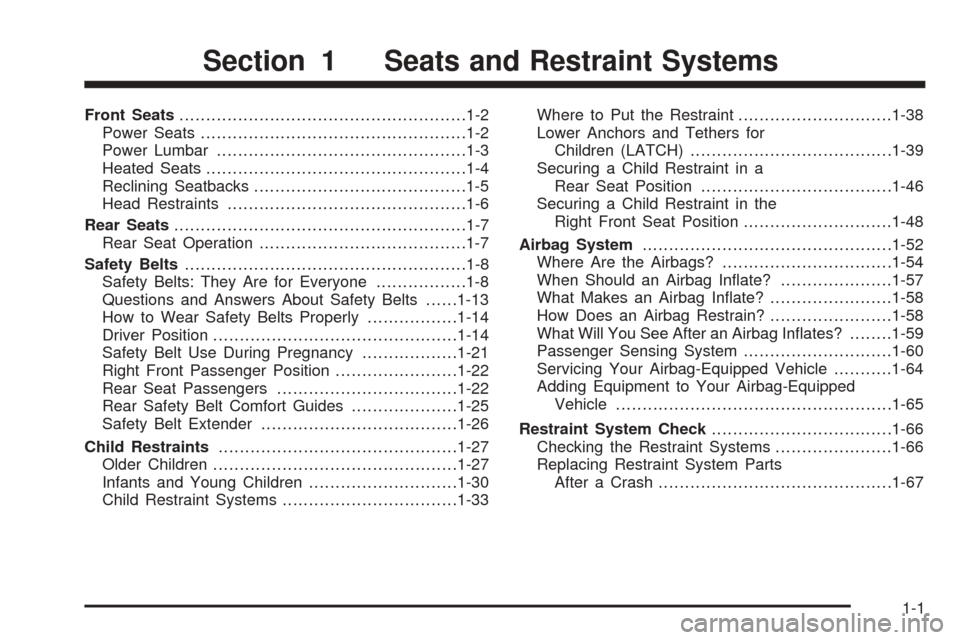
Front Seats......................................................1-2
Power Seats..................................................1-2
Power Lumbar...............................................1-3
Heated Seats.................................................1-4
Reclining Seatbacks........................................1-5
Head Restraints.............................................1-6
Rear Seats.......................................................1-7
Rear Seat Operation.......................................1-7
Safety Belts.....................................................1-8
Safety Belts: They Are for Everyone.................1-8
Questions and Answers About Safety Belts......1-13
How to Wear Safety Belts Properly.................1-14
Driver Position..............................................1-14
Safety Belt Use During Pregnancy..................1-21
Right Front Passenger Position.......................1-22
Rear Seat Passengers..................................1-22
Rear Safety Belt Comfort Guides....................1-25
Safety Belt Extender.....................................1-26
Child Restraints.............................................1-27
Older Children..............................................1-27
Infants and Young Children............................1-30
Child Restraint Systems.................................1-33Where to Put the Restraint.............................1-38
Lower Anchors and Tethers for
Children (LATCH)......................................1-39
Securing a Child Restraint in a
Rear Seat Position....................................1-46
Securing a Child Restraint in the
Right Front Seat Position............................1-48
Airbag System...............................................1-52
Where Are the Airbags?................................1-54
When Should an Airbag In�ate?.....................1-57
What Makes an Airbag In�ate?.......................1-58
How Does an Airbag Restrain?.......................1-58
What Will You See After an Airbag In�ates?........1-59
Passenger Sensing System............................1-60
Servicing Your Airbag-Equipped Vehicle...........1-64
Adding Equipment to Your Airbag-Equipped
Vehicle....................................................1-65
Restraint System Check..................................1-66
Checking the Restraint Systems......................1-66
Replacing Restraint System Parts
After a Crash............................................1-67
Section 1 Seats and Restraint Systems
1-1
Page 20 of 484
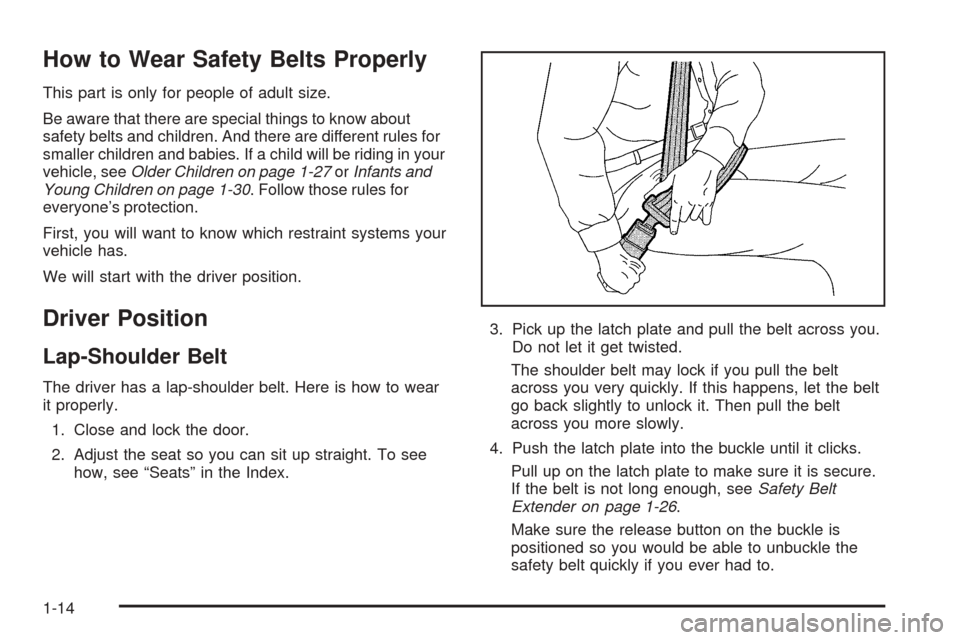
How to Wear Safety Belts Properly
This part is only for people of adult size.
Be aware that there are special things to know about
safety belts and children. And there are different rules for
smaller children and babies. If a child will be riding in your
vehicle, seeOlder Children on page 1-27orInfants and
Young Children on page 1-30. Follow those rules for
everyone’s protection.
First, you will want to know which restraint systems your
vehicle has.
We will start with the driver position.
Driver Position
Lap-Shoulder Belt
The driver has a lap-shoulder belt. Here is how to wear
it properly.
1. Close and lock the door.
2. Adjust the seat so you can sit up straight. To see
how, see “Seats” in the Index.3. Pick up the latch plate and pull the belt across you.
Do not let it get twisted.
The shoulder belt may lock if you pull the belt
across you very quickly. If this happens, let the belt
go back slightly to unlock it. Then pull the belt
across you more slowly.
4. Push the latch plate into the buckle until it clicks.
Pull up on the latch plate to make sure it is secure.
If the belt is not long enough, seeSafety Belt
Extender on page 1-26.
Make sure the release button on the buckle is
positioned so you would be able to unbuckle the
safety belt quickly if you ever had to.
1-14
Page 29 of 484

2. Push the latch plate into the buckle until it clicks.
Pull up on the latch plate to make sure it is secure.
When the shoulder belt is pulled out all the way,
it will lock. If it does, let it go back all the way and
start again.
If the belt is not long enough, seeSafety Belt
Extender on page 1-26.
Make sure the release button on the buckle is
positioned so you would be able to unbuckle the
safety belt quickly if you ever had to.
3. To make the lap part tight, pull up on the
shoulder part.
1-23
Page 32 of 484
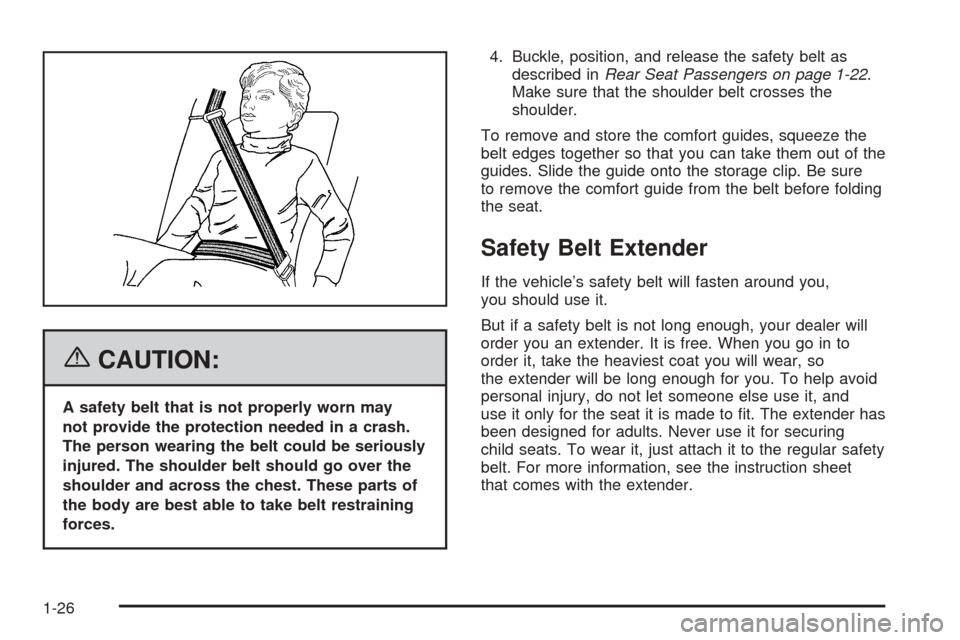
{CAUTION:
A safety belt that is not properly worn may
not provide the protection needed in a crash.
The person wearing the belt could be seriously
injured. The shoulder belt should go over the
shoulder and across the chest. These parts of
the body are best able to take belt restraining
forces.4. Buckle, position, and release the safety belt as
described inRear Seat Passengers on page 1-22.
Make sure that the shoulder belt crosses the
shoulder.
To remove and store the comfort guides, squeeze the
belt edges together so that you can take them out of the
guides. Slide the guide onto the storage clip. Be sure
to remove the comfort guide from the belt before folding
the seat.
Safety Belt Extender
If the vehicle’s safety belt will fasten around you,
you should use it.
But if a safety belt is not long enough, your dealer will
order you an extender. It is free. When you go in to
order it, take the heaviest coat you will wear, so
the extender will be long enough for you. To help avoid
personal injury, do not let someone else use it, and
use it only for the seat it is made to �t. The extender has
been designed for adults. Never use it for securing
child seats. To wear it, just attach it to the regular safety
belt. For more information, see the instruction sheet
that comes with the extender.
1-26
Page 36 of 484
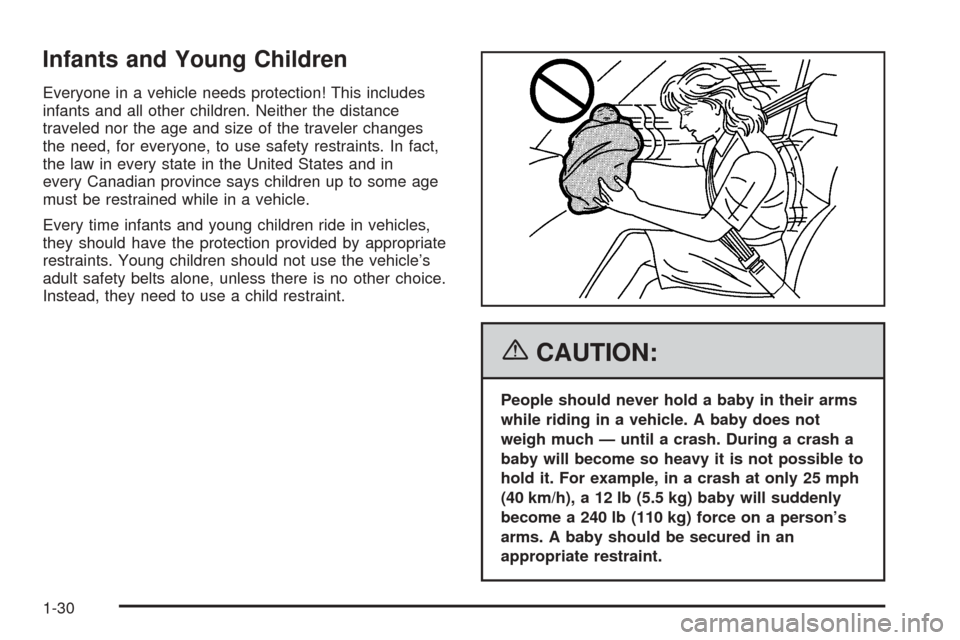
Infants and Young Children
Everyone in a vehicle needs protection! This includes
infants and all other children. Neither the distance
traveled nor the age and size of the traveler changes
the need, for everyone, to use safety restraints. In fact,
the law in every state in the United States and in
every Canadian province says children up to some age
must be restrained while in a vehicle.
Every time infants and young children ride in vehicles,
they should have the protection provided by appropriate
restraints. Young children should not use the vehicle’s
adult safety belts alone, unless there is no other choice.
Instead, they need to use a child restraint.
{CAUTION:
People should never hold a baby in their arms
while riding in a vehicle. A baby does not
weigh much — until a crash. During a crash a
baby will become so heavy it is not possible to
hold it. For example, in a crash at only 25 mph
(40 km/h), a 12 lb (5.5 kg) baby will suddenly
become a 240 lb (110 kg) force on a person’s
arms. A baby should be secured in an
appropriate restraint.
1-30
Page 38 of 484
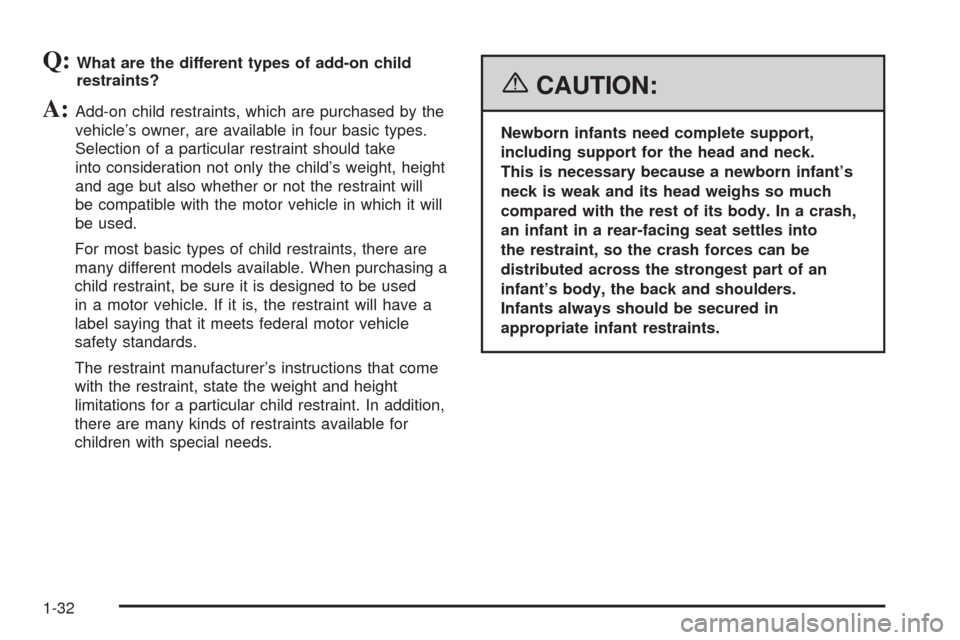
Q:What are the different types of add-on child
restraints?
A:Add-on child restraints, which are purchased by the
vehicle’s owner, are available in four basic types.
Selection of a particular restraint should take
into consideration not only the child’s weight, height
and age but also whether or not the restraint will
be compatible with the motor vehicle in which it will
be used.
For most basic types of child restraints, there are
many different models available. When purchasing a
child restraint, be sure it is designed to be used
in a motor vehicle. If it is, the restraint will have a
label saying that it meets federal motor vehicle
safety standards.
The restraint manufacturer’s instructions that come
with the restraint, state the weight and height
limitations for a particular child restraint. In addition,
there are many kinds of restraints available for
children with special needs.
{CAUTION:
Newborn infants need complete support,
including support for the head and neck.
This is necessary because a newborn infant’s
neck is weak and its head weighs so much
compared with the rest of its body. In a crash,
an infant in a rear-facing seat settles into
the restraint, so the crash forces can be
distributed across the strongest part of an
infant’s body, the back and shoulders.
Infants always should be secured in
appropriate infant restraints.
1-32
Page 39 of 484
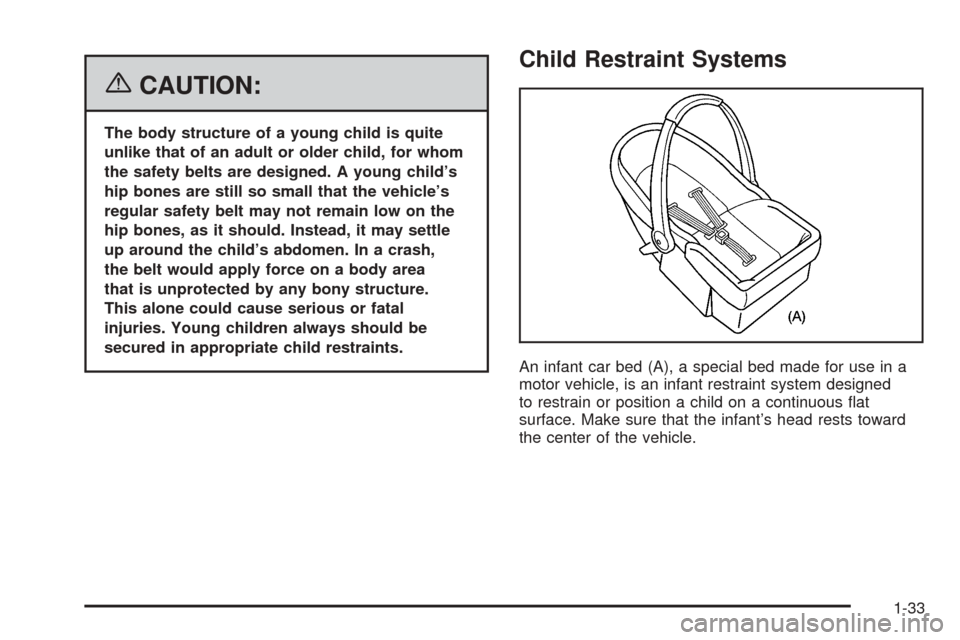
{CAUTION:
The body structure of a young child is quite
unlike that of an adult or older child, for whom
the safety belts are designed. A young child’s
hip bones are still so small that the vehicle’s
regular safety belt may not remain low on the
hip bones, as it should. Instead, it may settle
up around the child’s abdomen. In a crash,
the belt would apply force on a body area
that is unprotected by any bony structure.
This alone could cause serious or fatal
injuries. Young children always should be
secured in appropriate child restraints.
Child Restraint Systems
An infant car bed (A), a special bed made for use in a
motor vehicle, is an infant restraint system designed
to restrain or position a child on a continuous �at
surface. Make sure that the infant’s head rests toward
the center of the vehicle.
1-33
Page 41 of 484
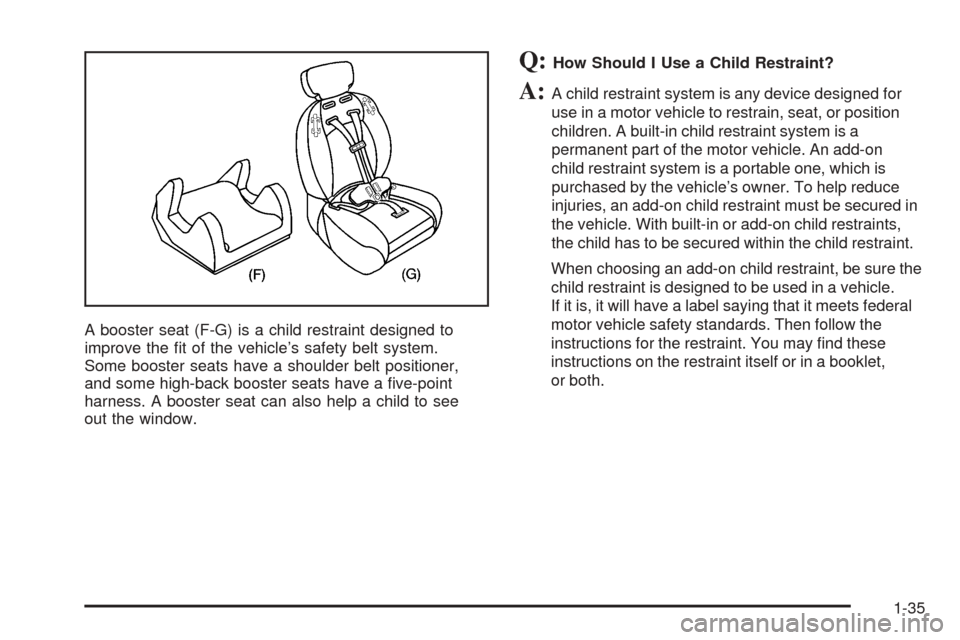
A booster seat (F-G) is a child restraint designed to
improve the �t of the vehicle’s safety belt system.
Some booster seats have a shoulder belt positioner,
and some high-back booster seats have a �ve-point
harness. A booster seat can also help a child to see
out the window.
Q:How Should I Use a Child Restraint?
A:A child restraint system is any device designed for
use in a motor vehicle to restrain, seat, or position
children. A built-in child restraint system is a
permanent part of the motor vehicle. An add-on
child restraint system is a portable one, which is
purchased by the vehicle’s owner. To help reduce
injuries, an add-on child restraint must be secured in
the vehicle. With built-in or add-on child restraints,
the child has to be secured within the child restraint.
When choosing an add-on child restraint, be sure the
child restraint is designed to be used in a vehicle.
If it is, it will have a label saying that it meets federal
motor vehicle safety standards. Then follow the
instructions for the restraint. You may �nd these
instructions on the restraint itself or in a booklet,
or both.
1-35
Page 42 of 484
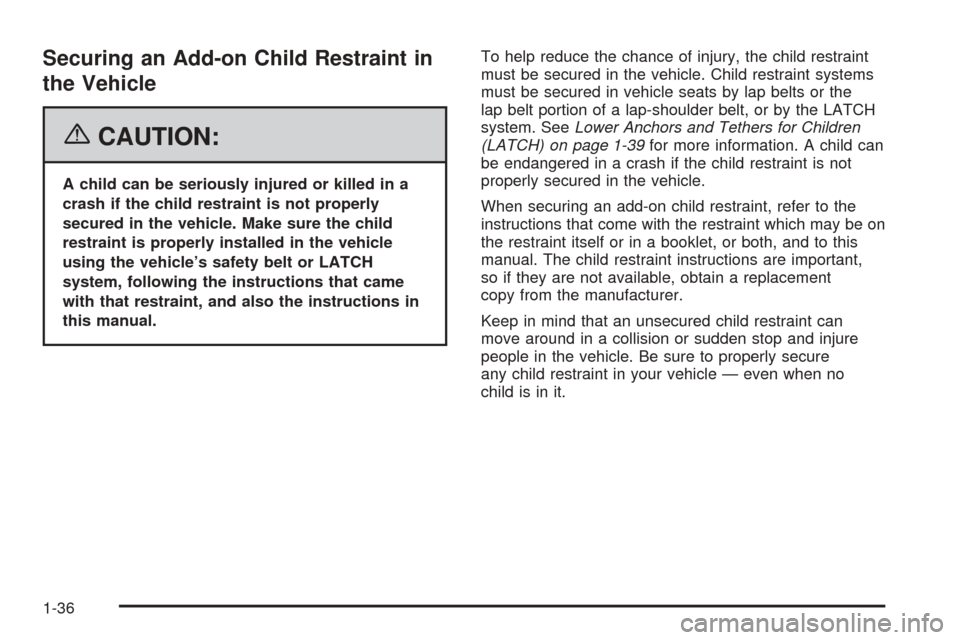
Securing an Add-on Child Restraint in
the Vehicle
{CAUTION:
A child can be seriously injured or killed in a
crash if the child restraint is not properly
secured in the vehicle. Make sure the child
restraint is properly installed in the vehicle
using the vehicle’s safety belt or LATCH
system, following the instructions that came
with that restraint, and also the instructions in
this manual.To help reduce the chance of injury, the child restraint
must be secured in the vehicle. Child restraint systems
must be secured in vehicle seats by lap belts or the
lap belt portion of a lap-shoulder belt, or by the LATCH
system. SeeLower Anchors and Tethers for Children
(LATCH) on page 1-39for more information. A child can
be endangered in a crash if the child restraint is not
properly secured in the vehicle.
When securing an add-on child restraint, refer to the
instructions that come with the restraint which may be on
the restraint itself or in a booklet, or both, and to this
manual. The child restraint instructions are important,
so if they are not available, obtain a replacement
copy from the manufacturer.
Keep in mind that an unsecured child restraint can
move around in a collision or sudden stop and injure
people in the vehicle. Be sure to properly secure
any child restraint in your vehicle — even when no
child is in it.
1-36
Page 43 of 484
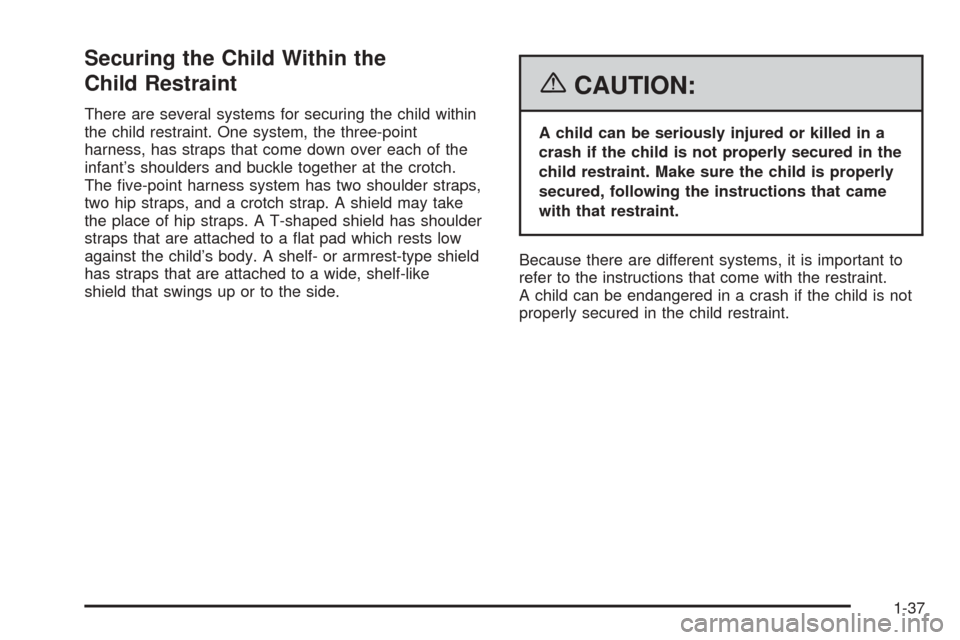
Securing the Child Within the
Child Restraint
There are several systems for securing the child within
the child restraint. One system, the three-point
harness, has straps that come down over each of the
infant’s shoulders and buckle together at the crotch.
The �ve-point harness system has two shoulder straps,
two hip straps, and a crotch strap. A shield may take
the place of hip straps. A T-shaped shield has shoulder
straps that are attached to a �at pad which rests low
against the child’s body. A shelf- or armrest-type shield
has straps that are attached to a wide, shelf-like
shield that swings up or to the side.
{CAUTION:
A child can be seriously injured or killed in a
crash if the child is not properly secured in the
child restraint. Make sure the child is properly
secured, following the instructions that came
with that restraint.
Because there are different systems, it is important to
refer to the instructions that come with the restraint.
A child can be endangered in a crash if the child is not
properly secured in the child restraint.
1-37